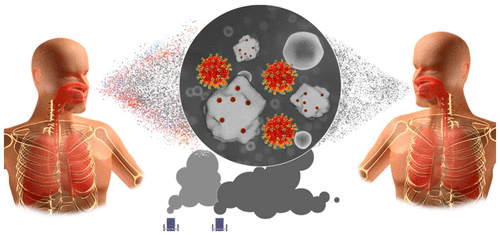Our official English website, www.x-mol.net, welcomes your
feedback! (Note: you will need to create a separate account there.)
Airborne Transmission of COVID-19: Aerosol Dispersion, Lung Deposition, and Virus-Receptor Interactions
ACS Nano ( IF 15.8 ) Pub Date : 2020-11-25 , DOI: 10.1021/acsnano.0c08484 Yi Y Zuo 1, 2 , William E Uspal 1 , Tao Wei 3
ACS Nano ( IF 15.8 ) Pub Date : 2020-11-25 , DOI: 10.1021/acsnano.0c08484 Yi Y Zuo 1, 2 , William E Uspal 1 , Tao Wei 3
Affiliation

|
Coronavirus disease 2019 (COVID-19), due to infection by the severe acute respiratory syndrome coronavirus 2 (SARS-CoV-2), is now causing a global pandemic. Aerosol transmission of COVID-19, although plausible, has not been confirmed by the World Health Organization (WHO) as a general transmission route. Considering the rapid spread of SARS-CoV-2, especially nosocomial outbreaks and other superspreading events, there is an urgent need to study the possibility of airborne transmission and its impact on the lung, the primary body organ attacked by the virus. Here, we review the complete pathway of airborne transmission of SARS-CoV-2 from aerosol dispersion in air to subsequent biological uptake after inhalation. In particular, we first review the aerodynamic and colloidal mechanisms by which aerosols disperse and transmit in air and deposit onto surfaces. We then review the fundamental mechanisms that govern regional deposition of micro- and nanoparticles in the lung. Focus is given to biophysical interactions between particles and the pulmonary surfactant film, the initial alveolar-capillary barrier and first-line host defense system against inhaled particles and pathogens. Finally, we summarize the current understanding about the structural dynamics of the SARS-CoV-2 spike protein and its interactions with receptors at the atomistic and molecular scales, primarily as revealed by molecular dynamics simulations. This review provides urgent and multidisciplinary knowledge toward understanding the airborne transmission of SARS-CoV-2 and its health impact on the respiratory system.
中文翻译:

COVID-19 的空气传播:气溶胶扩散、肺部沉积和病毒-受体相互作用
2019 年冠状病毒病 (COVID-19) 是由严重急性呼吸系统综合症冠状病毒 2 (SARS-CoV-2) 感染引起的,目前正在全球范围内引发大流行。尽管有可能通过气溶胶传播 COVID-19,但世界卫生组织 (WHO) 尚未确认其为一般传播途径。考虑到SARS-CoV-2的快速传播,特别是医院内暴发和其他超级传播事件,迫切需要研究空气传播的可能性及其对肺部(受病毒攻击的主要身体器官)的影响。在这里,我们回顾了 SARS-CoV-2 从空气中的气溶胶分散到吸入后生物吸收的完整空气传播途径。特别是,我们首先回顾了气溶胶在空气中分散和传播并沉积到表面的空气动力学和胶体机制。然后,我们回顾了控制肺部中微米颗粒和纳米颗粒区域沉积的基本机制。重点关注颗粒与肺表面活性剂膜、初始肺泡毛细血管屏障以及针对吸入颗粒和病原体的一线宿主防御系统之间的生物物理相互作用。最后,我们总结了目前对 SARS-CoV-2 刺突蛋白结构动力学及其在原子和分子尺度上与受体相互作用的理解,主要是通过分子动力学模拟揭示的。这篇综述为了解 SARS-CoV-2 的空气传播及其对呼吸系统健康的影响提供了紧迫的多学科知识。
更新日期:2020-12-22
中文翻译:

COVID-19 的空气传播:气溶胶扩散、肺部沉积和病毒-受体相互作用
2019 年冠状病毒病 (COVID-19) 是由严重急性呼吸系统综合症冠状病毒 2 (SARS-CoV-2) 感染引起的,目前正在全球范围内引发大流行。尽管有可能通过气溶胶传播 COVID-19,但世界卫生组织 (WHO) 尚未确认其为一般传播途径。考虑到SARS-CoV-2的快速传播,特别是医院内暴发和其他超级传播事件,迫切需要研究空气传播的可能性及其对肺部(受病毒攻击的主要身体器官)的影响。在这里,我们回顾了 SARS-CoV-2 从空气中的气溶胶分散到吸入后生物吸收的完整空气传播途径。特别是,我们首先回顾了气溶胶在空气中分散和传播并沉积到表面的空气动力学和胶体机制。然后,我们回顾了控制肺部中微米颗粒和纳米颗粒区域沉积的基本机制。重点关注颗粒与肺表面活性剂膜、初始肺泡毛细血管屏障以及针对吸入颗粒和病原体的一线宿主防御系统之间的生物物理相互作用。最后,我们总结了目前对 SARS-CoV-2 刺突蛋白结构动力学及其在原子和分子尺度上与受体相互作用的理解,主要是通过分子动力学模拟揭示的。这篇综述为了解 SARS-CoV-2 的空气传播及其对呼吸系统健康的影响提供了紧迫的多学科知识。











































 京公网安备 11010802027423号
京公网安备 11010802027423号